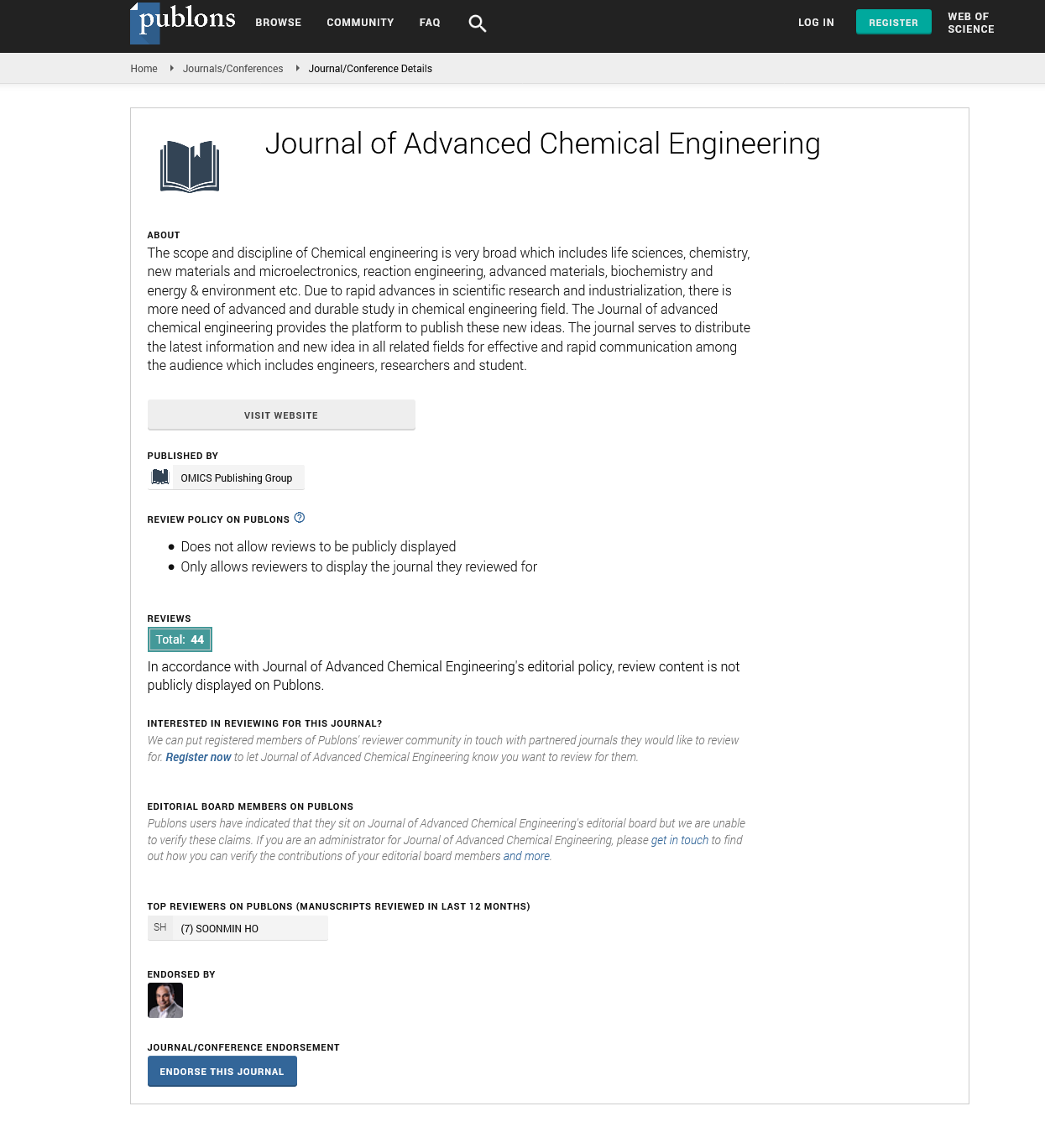Indexed In
- Open J Gate
- Genamics JournalSeek
- Smithers Rapra
- RefSeek
- Directory of Research Journal Indexing (DRJI)
- Hamdard University
- EBSCO A-Z
- OCLC- WorldCat
- Scholarsteer
- Publons
- Geneva Foundation for Medical Education and Research
- Google Scholar
Useful Links
Share This Page
Journal Flyer

Open Access Journals
- Agri and Aquaculture
- Biochemistry
- Bioinformatics & Systems Biology
- Business & Management
- Chemistry
- Clinical Sciences
- Engineering
- Food & Nutrition
- General Science
- Genetics & Molecular Biology
- Immunology & Microbiology
- Medical Sciences
- Neuroscience & Psychology
- Nursing & Health Care
- Pharmaceutical Sciences
Commentary - (2022) Volume 12, Issue 10
A Multifaceted Approach to Chemical and Biochemical Engineering
Li Imrau*Received: 03-Oct-2022, Manuscript No. JACE-22-18865; Editor assigned: 06-Oct-2022, Pre QC No. JACE-22-18865 (PQ); Reviewed: 21-Oct-2022, QC No. JACE-22-18865; Revised: 31-Oct-2022, Manuscript No. JACE-22-18865 (R); Published: 07-Nov-2022, DOI: 10. 35248/2090-4568.22.12.251
Description
The process industry requires that operations be carried out in the most efficient manner possible, whether in terms of product quality, energy, or time, or in terms of economics. Alternative novel technologies are constantly sought to reduce total processing costs while maintaining or improving product quality while remaining environmentally friendly. Cavitation has enormous potential for increasing the intensity of physical or chemical processing while using less energy. Cavitation is broadly defined as the formation, growth, and collapse of cavities, resulting in extremely high local energy densities. Cavitation in a reactor produces very high temperatures and pressures (100-5000 atmospheres of pressure and 500-15000 K of temperature) locally, but the overall environment remains equivalent to ambient atmospheric conditions. This enables the effective execution of various physical processes or chemical reactions that require stringent conditions under ambient conditions. Furthermore, free radicals are produced during the process as a result of the dissociation of vapours trapped in the cavitating bubbles, which either intensifies the chemical reactions or changes the reaction mechanism [1].
Cavitation also causes local turbulence and liquid microcirculation (acoustic streaming) in the reactor, which increases the rates of transport processes and eliminates mass transfer resistances in heterogeneous systems. Cavitation can also be classified as transient or stable based on the degree of intensity, which can be expressed in terms of pressure or temperature. The energy requirements for these two types of generation are significantly different, so proper care must be taken when selecting the operating parameters for the specific type of application [2]. The temperature of the vapour within the bubble may be several thousand Kelvin at the point of total collapse, and the pressure may be several hundred atmospheres. Small bubbles in a liquid are forced to oscillate in size or shape due to some form of energy input, such as an acoustic field, in the case of stable or non-inertial cavitation, when the intensity of the energy input is insufficient to cause total bubble collapse. This type of cavitation has much milder cavitational effects than transient cavitation [3].
Most quantitative engineering theories and calculations rely on a combination of three fundamental concepts: balances (e.g., mass, elemental, energy, momentum), equilibria (e.g., force, reaction, and phase equilibria), and kinetics (e.g. momentum and mass transfer, reaction and growth kinetics). While balances and kinetic models have been extensively developed and used in biotechnology, equilibrium aspects and thermodynamics have received relatively little attention thus far. One of the many reasons why development and design of biotechnological processes are currently primarily conducted essentially empirically and why bioprocesses are frequently not as thoroughly optimised as many chemical processes is the result of the lack of fundamental data concerning biomolecular properties, thermodynamic equilibrium position, formulation of driving forces, and energy efficiency relations in biotechnology [4].
Industrial biotechnology in combination with industrial chemical technology is poised to alter the modern world in the same way it did in the 20th century. Chemical and biochemical engineering is the discipline that underpins these achievements (C&BE) [5]. In order to develop better materials, products, and processes that benefit society, the discipline applies, among other things, the fundamental concepts of thermodynamics, reaction stoichiometry and kinetics, biochemistry, and cell biology as well as transport phenomena. To put it another way, on a technical level, chemical and biochemical (C&B) engineers work with unit operations for the purposes of chemical and/or biochemical synthesis followed by downstream separations, all of which are based on phenomena like thermodynamics, reactions (chemical, biochemical, or thermal conversions), transport, and so on (mass, heat and momentum).
REFERENCES
- Matsuda Y, Gotfredsen CH, Larsen TO. Genetic characterization of neosartorin biosynthesis provides insight into heterodimeric natural product generation. Org Lett. 2018;20(22):7197-7200.
[Crossref] [Google Scholar][PubMed]
- Van Berkel WJ, Kamerbeek NM, Fraaije M. Flavoprotein monooxygenases, a diverse class of oxidative biocatalysts. J Biotechnol. 2006;124(4):670-89.
[Crossref] [Google Scholar][PubMed]
- Zhang W, Liu Z, Li S, Lu Y, Chen Y. Fluostatins I–K from the south China sea-derived Micromonospora rosaria SCSIO N160. J Nat Prod. 2012;75(11):1937-43.
[Crossref] [Google Scholar][PubMed]
- Shen Q, Dai G, Li A, Liu Y, Zhong G. Genome-Guided Discovery of Highly Oxygenated Aromatic Polyketides, Saccharothrixins D–M, from the Rare Marine Actinomycete Saccharothrix sp. D09. J Nat Prod. 2021;84(11):2875-2884.
[Crossref] [Google Scholar][PubMed]
- Yang C, Huang C, Fang C, Zhang L, Chen S. Inactivation of Flavoenzyme-Encoding Gene flsO1 in Fluostatin Biosynthesis Leads to Diversified Angucyclinone Derivatives. J Org Chem. 2021 ;86(16):11019-11028.
[Crossref] [Google Scholar][PubMed]
Citation: Imrau L (2022) A Multifaceted Approach to Chemical and Biochemical Engineering. Adv Chem Eng. 12:251.
Copyright: © 2022 Imrau L. This is an open-access article distributed under the terms of the Creative Commons Attribution License, which permits unrestricted use, distribution, and reproduction in any medium, provided the original author and source are credited.

